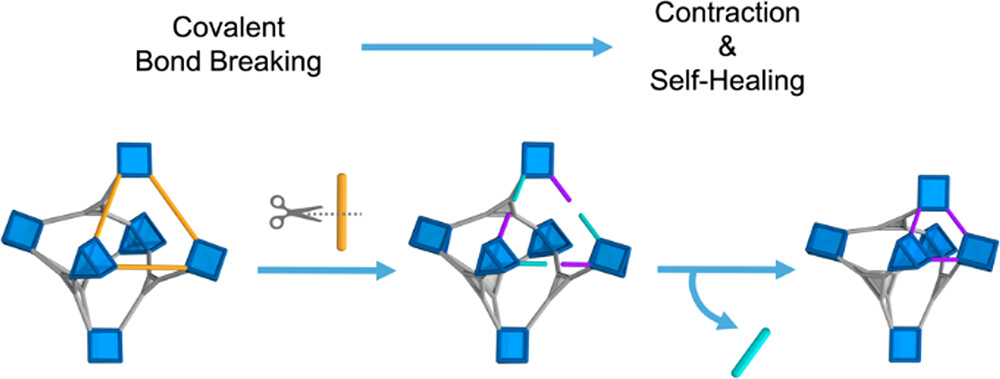Thursday, 31 August 2023
Clip off and rearrange: new MOF materials synthesized by selective bond breaking
Researchers at the Catalan Institute of Nanoscience and Nanotechnology (ICN2) created new materials of the metal-organic frameworks (MOFs) family using an innovative technique, based on cleavage of covalent bonds in known MOFs and consequent structural reorganization. This approach, inspired by the ‘Clip-Off Chemistry’ previously developed by the authors, is presented in a paper recently published in the Journal of the American Chemical Society (JACS).

Reticular chemistry, in which complex structures are assembled by bonding molecular ‘building blocks’, has enabled scientists to synthesize and study a wealth of new materials exhibiting peculiar characteristics, such as metal-organic frameworks (MOFs). MOFs are fascinating complex crystalline structures, based on metal clusters connected through organic linkers, that present a long-range periodic architecture and high porosity. They are extremely versatile and can be modified and functionalized in a variety of ways to best meet specific application requirements.
It is already known that new MOFs can be produced starting from an existing one (called ‘parent MOF’) by means of isoreticular chemistry, which consists in substituting only some pieces (moieties) of the original structure, whose replacement does not result in the destruction of the whole architecture. A technique to obtain an isoreticular MOF derived from a parent one is to replace a linker bridging two metal clusters with an externally introduced new linker. The substitute linker usually has equal or greater length than the original; but it can also be smaller, thus leading to a contraction of the framework.
A team of researchers coordinated by ICREA Prof. Daniel Maspoch and Dr Inhar Imaz –who are Group Leader and Senior Researcher, respectively, in the Supramolecular NanoChemistry and Materials Group at the Catalan Institute of Nanoscience and Nanotechnology (ICN2)— demonstrated that isoreticular MOFs can be generated by applying an innovative technique, based on cleavage of covalent bonds and consequent rearrangement of the structure’s components. This work, which was made possible by the ERC Advanced Grant secured by Prof. Maspoch with his project CLIPOFF-CHEM, is presented in a research article recently published in the Journal of the American Chemical Society (JACS) –with doctoral student Yunhui Yang as first author.
The researchers who carried out this study were inspired by a revolutionary synthesis strategy that they had previously developed, named Clip-Off Chemistry: it allows creating new molecules and materials by selectively cleaving some bonds in a reticular crystal. With an analogous approach, they were able to synthesize contracted isoreticular MOFs –i.e., MOFs with similar but contracted reticular structure as the parent one— without introducing external linkers.
The process starts with breaking covalent bonds of specific bridging linkers in the parent MOF, which results in two split ligands. One of them is then removed using a solvent and is not replaced. This triggers a contraction of the lattice and the establishment of a new bond between the ‘orphan’ ligand and an accessible metal ion/cluster in the structure.
This series of chemical and structural dynamic processes occurring in the framework, which the authors of the study dubbed self-healing process, leads to the formation of a new MOF; specifically, a contracted isoreticular one. The scientists were able to observe this process by means of a technique called single-crystal X-ray diffraction, thanks to the fact that the isoreticular transformation takes place in a single-crystal to single-crystal fashion.
Due to this chemical and structural modification, the new material will exhibit different properties compared to the parent MOF, which can be relevant or even crucial to some applications. This work proves, once again, the extraordinary versatility of metal-organic frameworks, as well as the remarkable potential of Clip-Off Chemistry for synthesizing new materials with desired properties and even for discovering new phenomena occurring in MOFs.
Reference article:
Yunhui Yang, Pilar Fernández-Seriñán, Inhar Imaz*, Felipe Gándara, Marcel Handke, Borja Ortín-Rubio, Judith Juanhuix, and Daniel Maspoch*, Isoreticular Contraction of Metal–Organic Frameworks Induced by Cleavage of Covalent Bonds, J. Am. Chem. Soc. 2023, 145, 31, 17398–17405. DOI: 10.1021/jacs.3c05469

